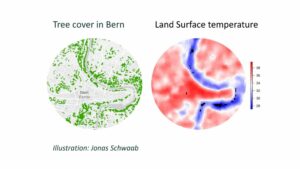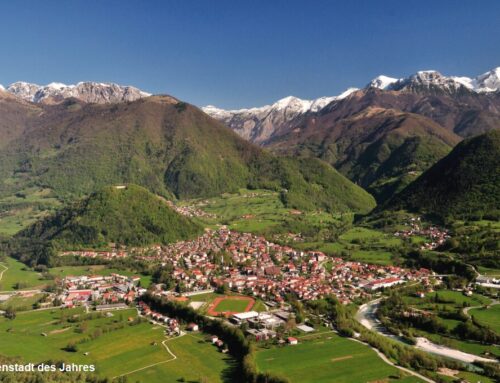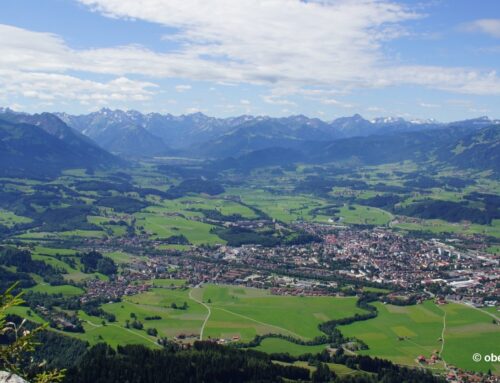Edouard Davin is Associate Professor for Climate Scenarios for Sustainable Development at the Wyss Academy for Nature. He has many years of experience in climate modelling and studies in particular the interactions between land use and climate. His work has shown, for example, that agriculture and forest management can play a very important role in climate protection. Edouard Davin has also led the development of a regionally linked biosphere-atmosphere climate model. This model has subsequently been used in a variety of scientific studies to better understand and predict the interactions between climate, land use and the carbon cycle.
For the Alpine Towns Blog we asked Edouard Davin a few questions:
What is your favourite city and why?
The city closest to my heart is Gap, the small city where I grew up in the Southern French Alps. Architecturally it is not particularly impressive, but it is embedded in a beautiful landscape surrounded by mountains. It is also a door connecting two worlds: the Mediterranean culture and climate to the South and the high peaks of the Ecrins national park to the North.
What is your research about and what goals are you pursuing?
I am a climate scientist interested in the interactions between climate and the terrestrial biosphere. A lot of my work aims at a better understanding of the role of land use change in transforming these interactions. Ultimately, my goal is to produce knowledge that can be used to design concrete solutions to climate change. For instance, by identifying farming practices that can help reduce greenhouse gas emissions from agriculture, or by quantifying potential climate benefits of forest conservation and restoration.
What conclusions can cities/urban planning in the Alps draw from the results of your research?
Working together with Jonas Schwaab, a colleague from ETH Zurich, we found that trees are an efficient way to reduce temperature in cities – in particular, during warm summer days. This means that conserving or re-introducing trees in cities is a promising climate adaptation strategy which can help reduce the negative impacts of heat waves on human comfort and health in urban areas. It is especially important in a context where this type of events are becoming more frequent due to climate change. Moreover, we found that at the European scale, the highest temperature reduction from trees is seen in cities located around the Alps and more generally in Central Europe. In other words, Alpine cities would particularly benefit from such measures.
How large does the proportion of trees/open spaces have to be in order to measure considerable impact on climate adaption?
Even isolated trees, or a small number of them, can generate a significant impact on temperature –through a shading effect and evaporative cooling. In other words, every tree counts! But the effect of isolated trees remains very local. If, however, a larger area is planted with trees or other green elements (such as a park), there is a higher chance that the cooling effect will be exported away from the green area itself, thus potentially benefiting neighbouring urban areas as well. But more research is still needed to fully understand the reach and magnitude of these neighbouring effects.
Which effect has the greater impact: cooling through blue infrastructure or cooling through extensive greening (if you can manage it)?
Blue infrastructures can also be an efficient way to reduce temperature through evaporative cooling, but unlike trees, they don’t provide an additional shading effect. They are also usually more difficult to integrate into the urban landscape due to the space requirement. That said, a combination of both measures is certainly a good approach in general. But the respective effectiveness of blue versus green infrastructure is context-dependent and still needs to be quantified more systematically.
What potential does green infrastructure hold for cities beyond their cooling effect?
Green infrastructures are a way to conserve or reintroduce biodiversity within urban areas. This is essential, given that biodiversity has been particularly eroded in these areas. They also have an essential function in promoting wellbeing and reconnecting city dwellers to nature. They can also provide other services such as food production, if these areas are used for urban farming. Urban vegetation also stores carbon, which could provide a source of income to cities in the context of a carbon market, for instance.
Do you think that the decrease in the cooling potential of trees during hot spells could be prevented by having tree species that are adapted to dryness/drought?
Yes, the tree species and its adaptation to local climate conditions (and future climate conditions) is essential to consider. Our research has shown, for instance, that broadleaf trees are more capable of maintaining a cooling effect even during a heat wave, compared to coniferous trees. Irrigation is also an important factor to consider here. If trees are watered, they can sustain their evapotranspiration and the associated cooling effect. But watering trees during dry and hot events can of course generate trade-offs if water is particularly scarce. That’s where an integrative design, interlinking blue and green infrastructures can really make a difference.
What will your further research look like?
I am building a new research team at the Wyss Academy for Nature at the University of Bern. One of our goals is to generate future scenarios that link climate, biodiversity and land use. This will be done by combining modelling and data science, while building upon interdisciplinary collaborations with biologists, economists and land system scientists. We would like, in particular, to identify sustainable development pathways that reconcile nature conservation and the achievement of ambitious climate goals, without hampering human wellbeing. This is of course very ambitious. But finding answers to these questions is such an urgent priority for humanity that I feel we cannot shy away from at least trying.

Illustration: Link between temperature and trees




